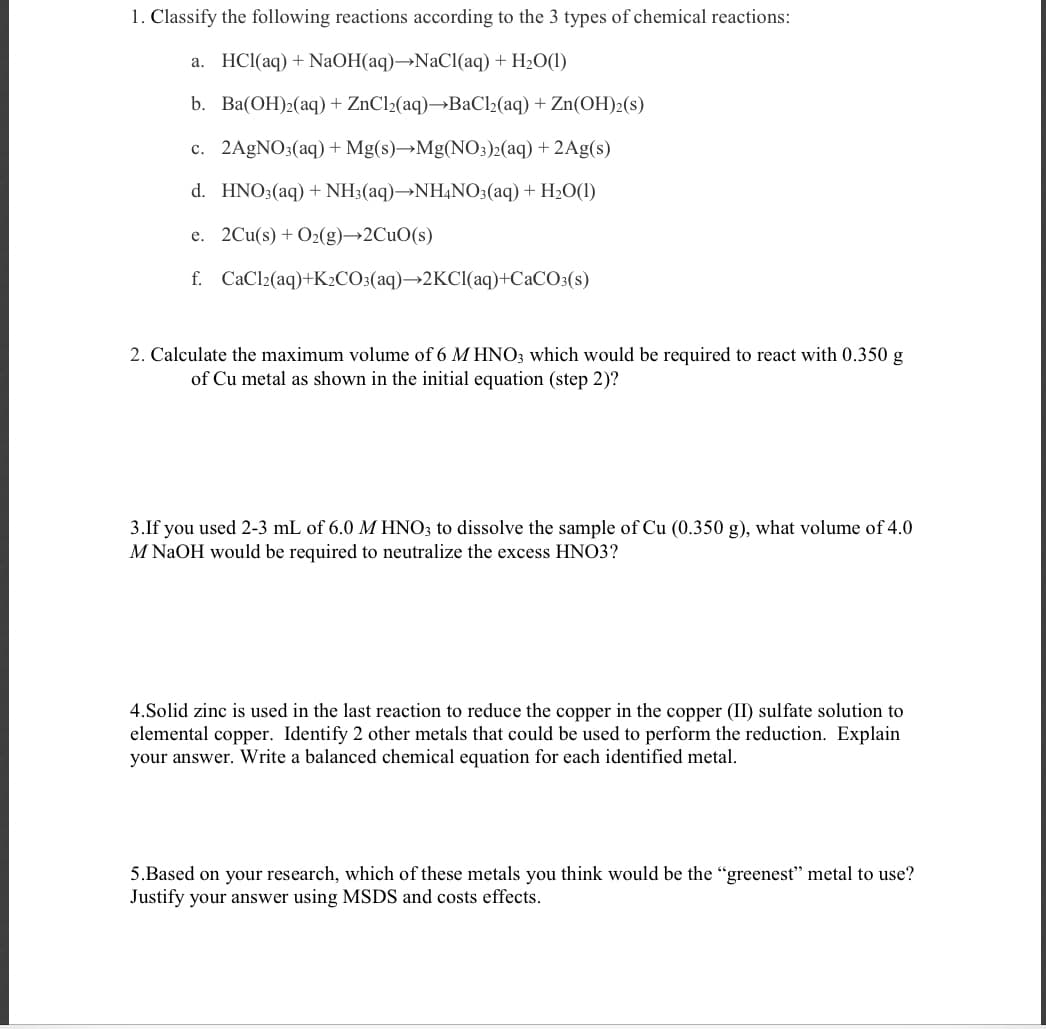1. Classify the following reactions according to the 3 types of chemical reactions: a. HCl(aq) + NaOH(aq)→NACI(aq) + H2O(1) b. Ba(ОН)2(аq) + ZnClz(aq)—ВаCl-(aq) + Zn(OH)2(s) c. 2AGNO3(aq) + Mg(s)→Mg(NO;)2(aq) + 2Ag(s) d. HNO3(aq) +NH3(aq)→NH¾NO3(aq) + H2O(1) e. 2Cu(s) + O2(g)→2CUO(s) f. CaCl2(aq)+K2CO:(aq)→2KCI(aq)+CaCO3(s) 2. Calculate the maximum volume of 6 M HNO3 which would be required to react with 0.350 g of Cu metal as shown in the initial equation (step 2)? 3.If you used 2-3 mL of 6.0 M HNO3 to dissolve the sample of Cu (0.350 g), what volume of 4.0 M NaOH would be required to neutralize the excess HNO3? 4.Solid zinc is used in the last reaction to reduce the copper in the copper (II) sulfate solution to elemental copper. Identify 2 other metals that could be used to perform the reduction. Explain your answer. Write a balanced chemical equation for each identified metal. 5.Based on your research, which of these metals you think would be the "greenest" metal to use? Justify your answer using MSDS and costs effects.
1. Classify the following reactions according to the 3 types of chemical reactions: a. HCl(aq) + NaOH(aq)→NACI(aq) + H2O(1) b. Ba(ОН)2(аq) + ZnClz(aq)—ВаCl-(aq) + Zn(OH)2(s) c. 2AGNO3(aq) + Mg(s)→Mg(NO;)2(aq) + 2Ag(s) d. HNO3(aq) +NH3(aq)→NH¾NO3(aq) + H2O(1) e. 2Cu(s) + O2(g)→2CUO(s) f. CaCl2(aq)+K2CO:(aq)→2KCI(aq)+CaCO3(s) 2. Calculate the maximum volume of 6 M HNO3 which would be required to react with 0.350 g of Cu metal as shown in the initial equation (step 2)? 3.If you used 2-3 mL of 6.0 M HNO3 to dissolve the sample of Cu (0.350 g), what volume of 4.0 M NaOH would be required to neutralize the excess HNO3? 4.Solid zinc is used in the last reaction to reduce the copper in the copper (II) sulfate solution to elemental copper. Identify 2 other metals that could be used to perform the reduction. Explain your answer. Write a balanced chemical equation for each identified metal. 5.Based on your research, which of these metals you think would be the "greenest" metal to use? Justify your answer using MSDS and costs effects.
Chemistry for Engineering Students
4th Edition
ISBN:9781337398909
Author:Lawrence S. Brown, Tom Holme
Publisher:Lawrence S. Brown, Tom Holme
Chapter4: Stoichiometry
Section: Chapter Questions
Problem 4.56PAE
Related questions
Question

Transcribed Image Text:1. Classify the following reactions according to the 3 types of chemical reactions:
a. HCl(aq) + NaOH(aq)→NaCl(aq) + H2O(1)
b. Ba(OH)2(aq) + ZnCl2(aq)→BaCl2(aq) + Zn(OH)2(s)
c. 2AGNO3(aq) + Mg(s)→Mg(NO3)2(aq) + 2Ag(s)
d. HNO3(aq) + NH;(aq)→NH,NO;(aq) + H2O(1)
e. 2Cu(s) + O2(g)→2CUO(s)
f. CaCl2(aq)+K2CO:(aq)→2KCI(aq)+CaCO3(s)
2. Calculate the maximum volume of 6 M HNO; which would be required to react with 0.350 g
of Cu metal as shown in the initial equation (step 2)?
3.If you used 2-3 mL of 6.0 M HNO3 to dissolve the sample of Cu (0.350 g), what volume of 4.0
M NAOH would be required to neutralize the excess HNO3?
4.Solid zinc is used in the last reaction to reduce the copper in the copper (II) sulfate solution to
elemental copper. Identify 2 other metals that could be used to perform the reduction. Explain
your answer. Write a balanced chemical equation for each identified metal.
5.Based on your research, which of these metals you think would be the
Justify your answer using MSDS and costs effects.
enest" metal to use?
Expert Solution
This question has been solved!
Explore an expertly crafted, step-by-step solution for a thorough understanding of key concepts.
This is a popular solution!
Trending now
This is a popular solution!
Step by step
Solved in 2 steps with 1 images

Recommended textbooks for you

Chemistry for Engineering Students
Chemistry
ISBN:
9781337398909
Author:
Lawrence S. Brown, Tom Holme
Publisher:
Cengage Learning

Introductory Chemistry: An Active Learning Approa…
Chemistry
ISBN:
9781305079250
Author:
Mark S. Cracolice, Ed Peters
Publisher:
Cengage Learning

Chemistry & Chemical Reactivity
Chemistry
ISBN:
9781337399074
Author:
John C. Kotz, Paul M. Treichel, John Townsend, David Treichel
Publisher:
Cengage Learning

Chemistry for Engineering Students
Chemistry
ISBN:
9781337398909
Author:
Lawrence S. Brown, Tom Holme
Publisher:
Cengage Learning

Introductory Chemistry: An Active Learning Approa…
Chemistry
ISBN:
9781305079250
Author:
Mark S. Cracolice, Ed Peters
Publisher:
Cengage Learning

Chemistry & Chemical Reactivity
Chemistry
ISBN:
9781337399074
Author:
John C. Kotz, Paul M. Treichel, John Townsend, David Treichel
Publisher:
Cengage Learning

Chemistry & Chemical Reactivity
Chemistry
ISBN:
9781133949640
Author:
John C. Kotz, Paul M. Treichel, John Townsend, David Treichel
Publisher:
Cengage Learning

Chemistry
Chemistry
ISBN:
9781305957404
Author:
Steven S. Zumdahl, Susan A. Zumdahl, Donald J. DeCoste
Publisher:
Cengage Learning
